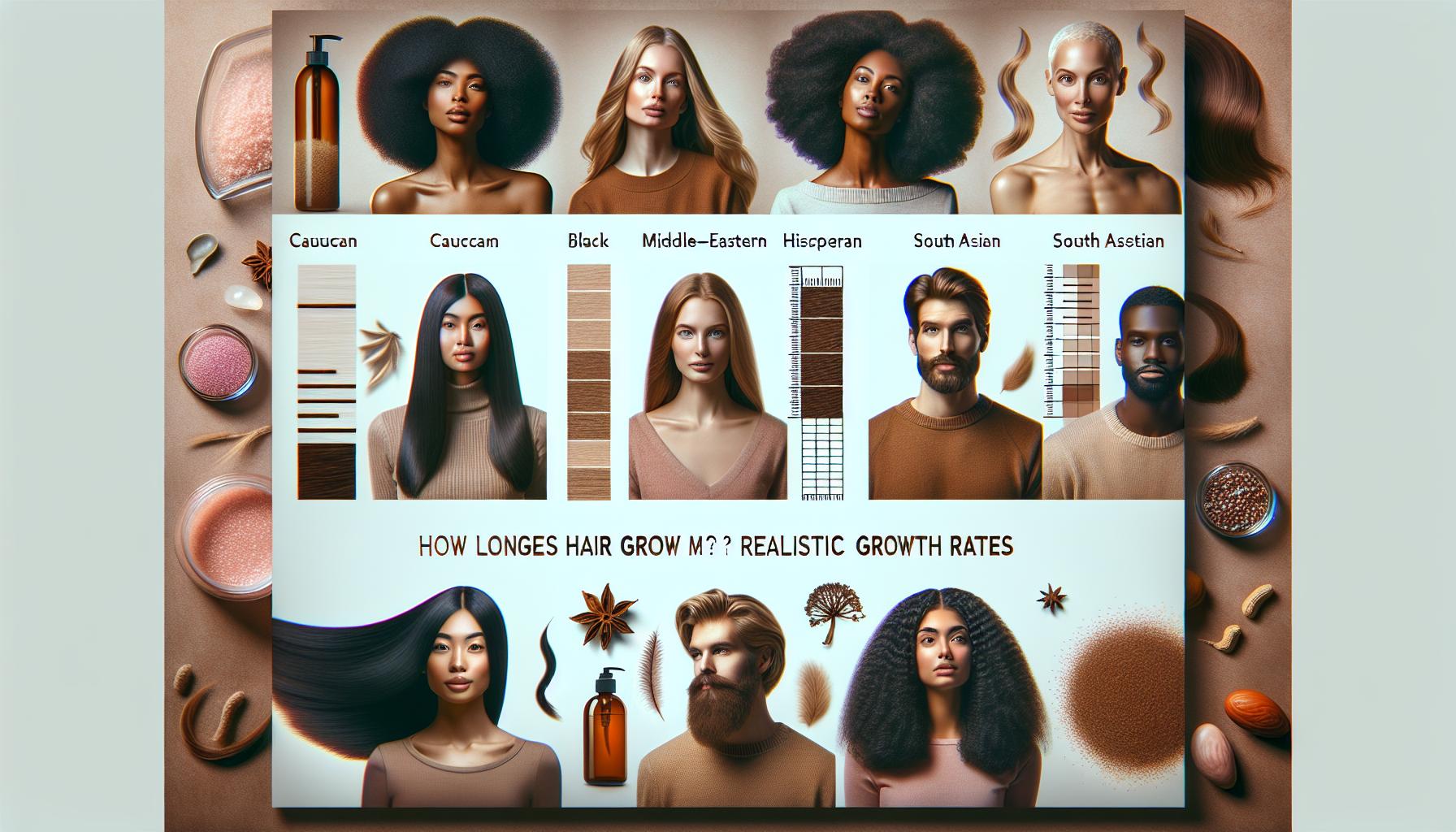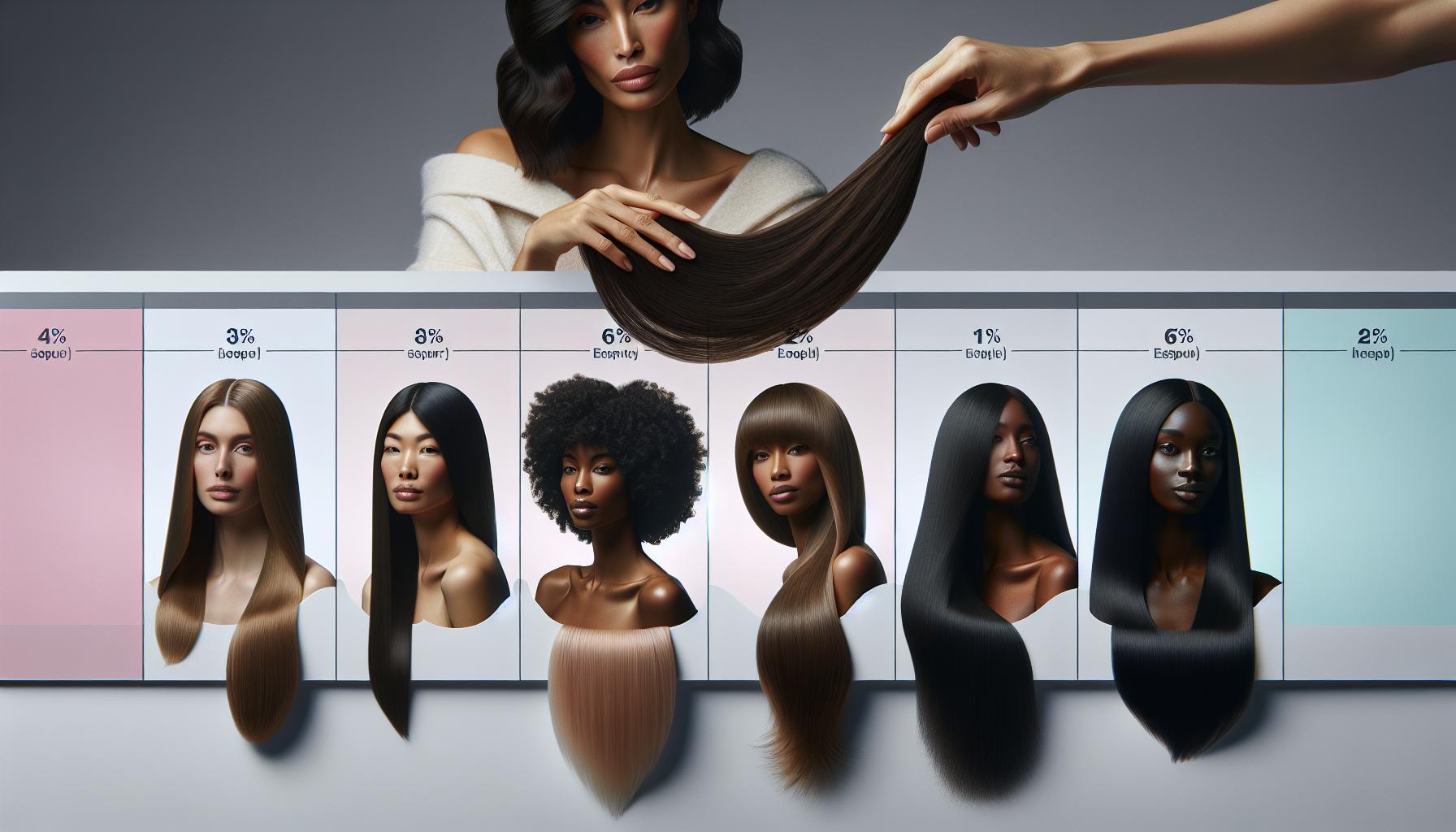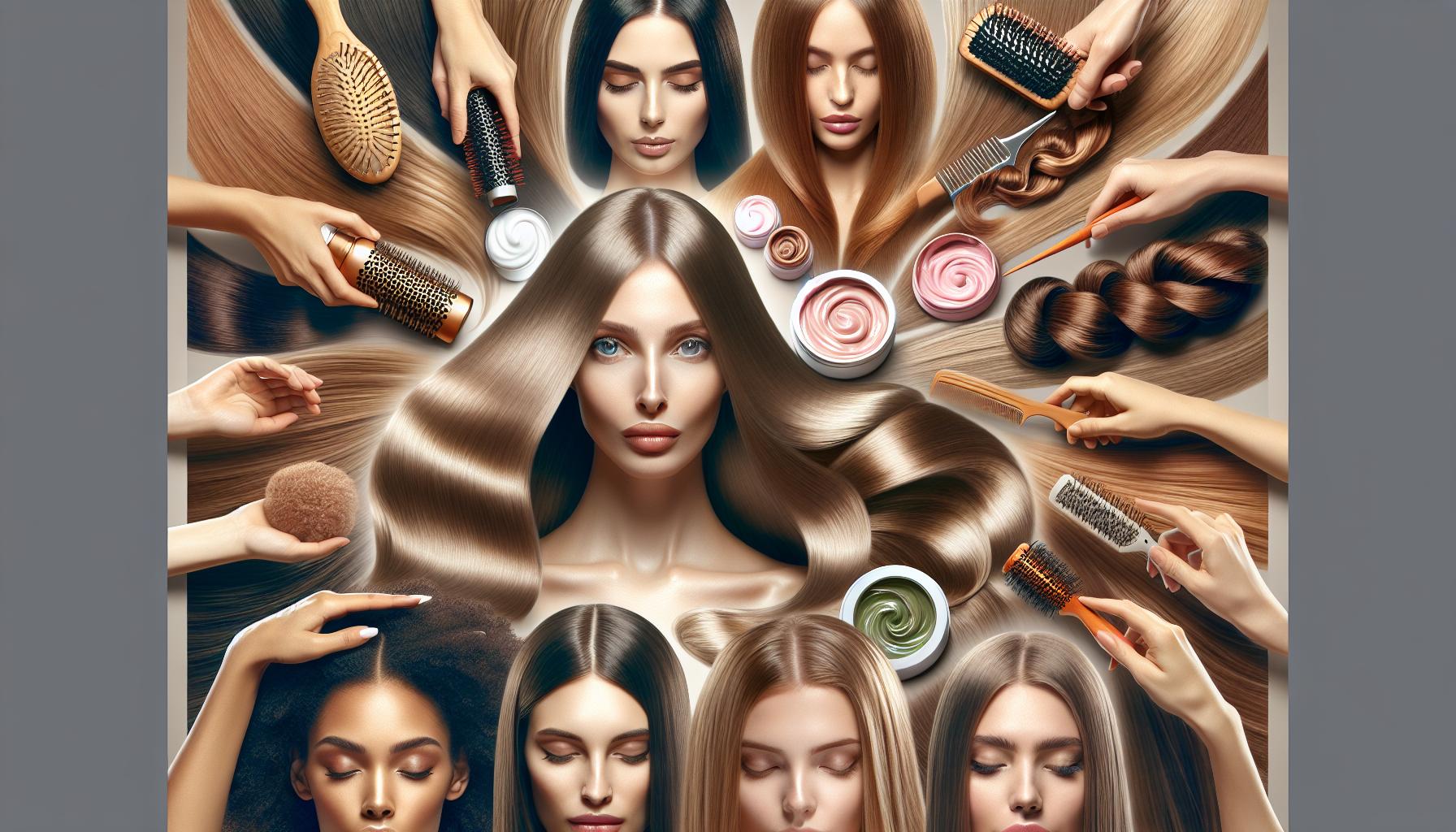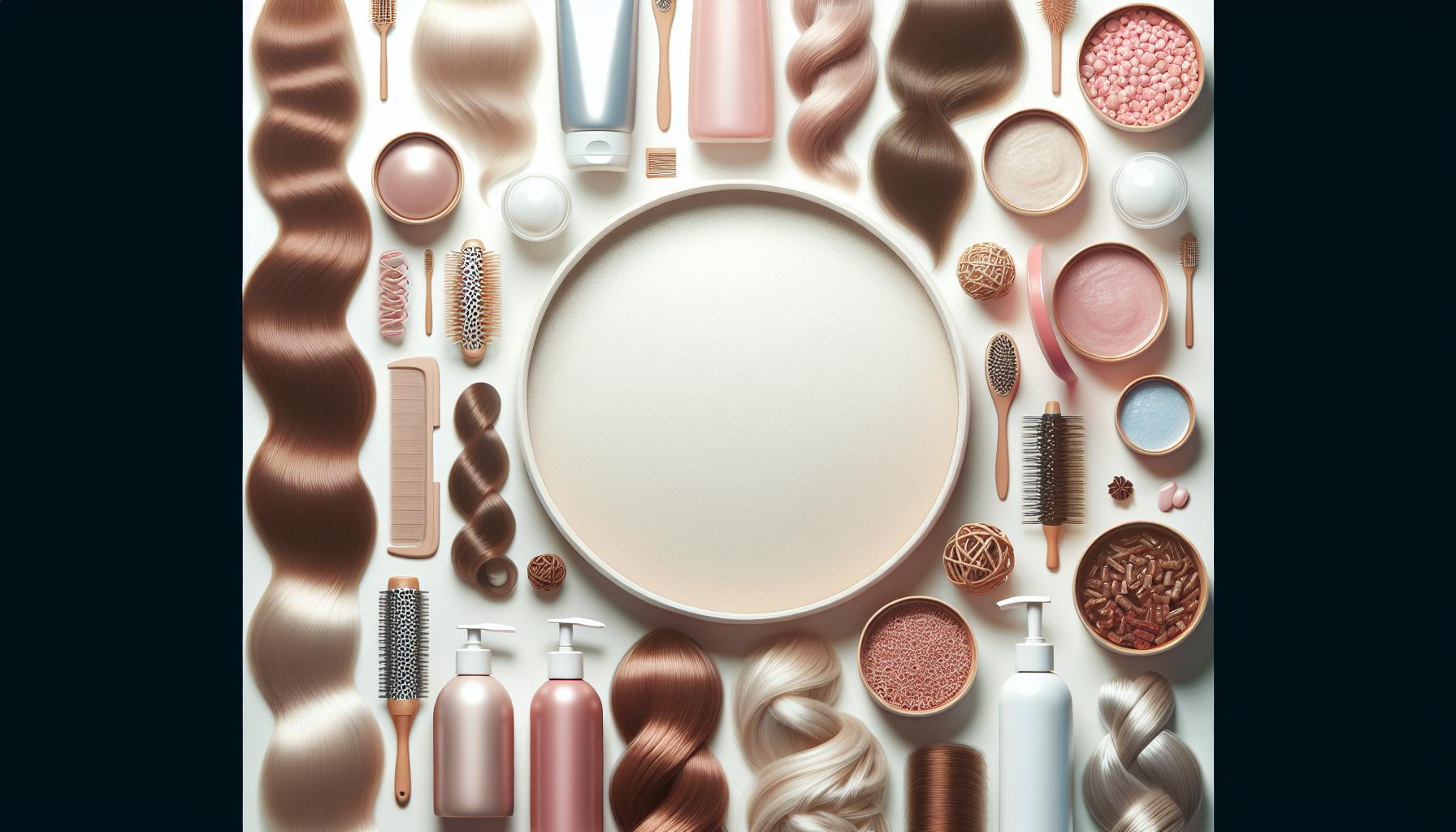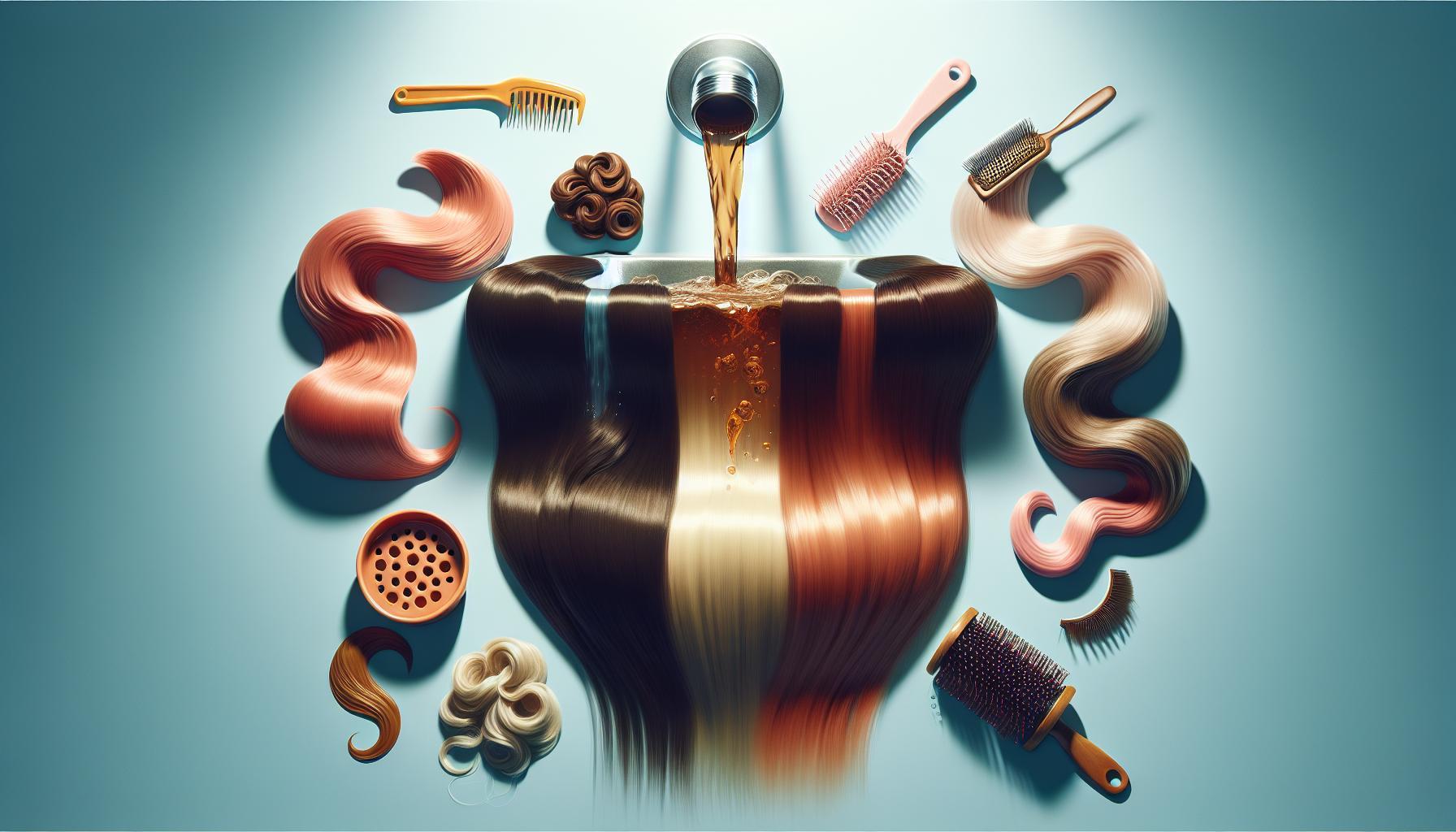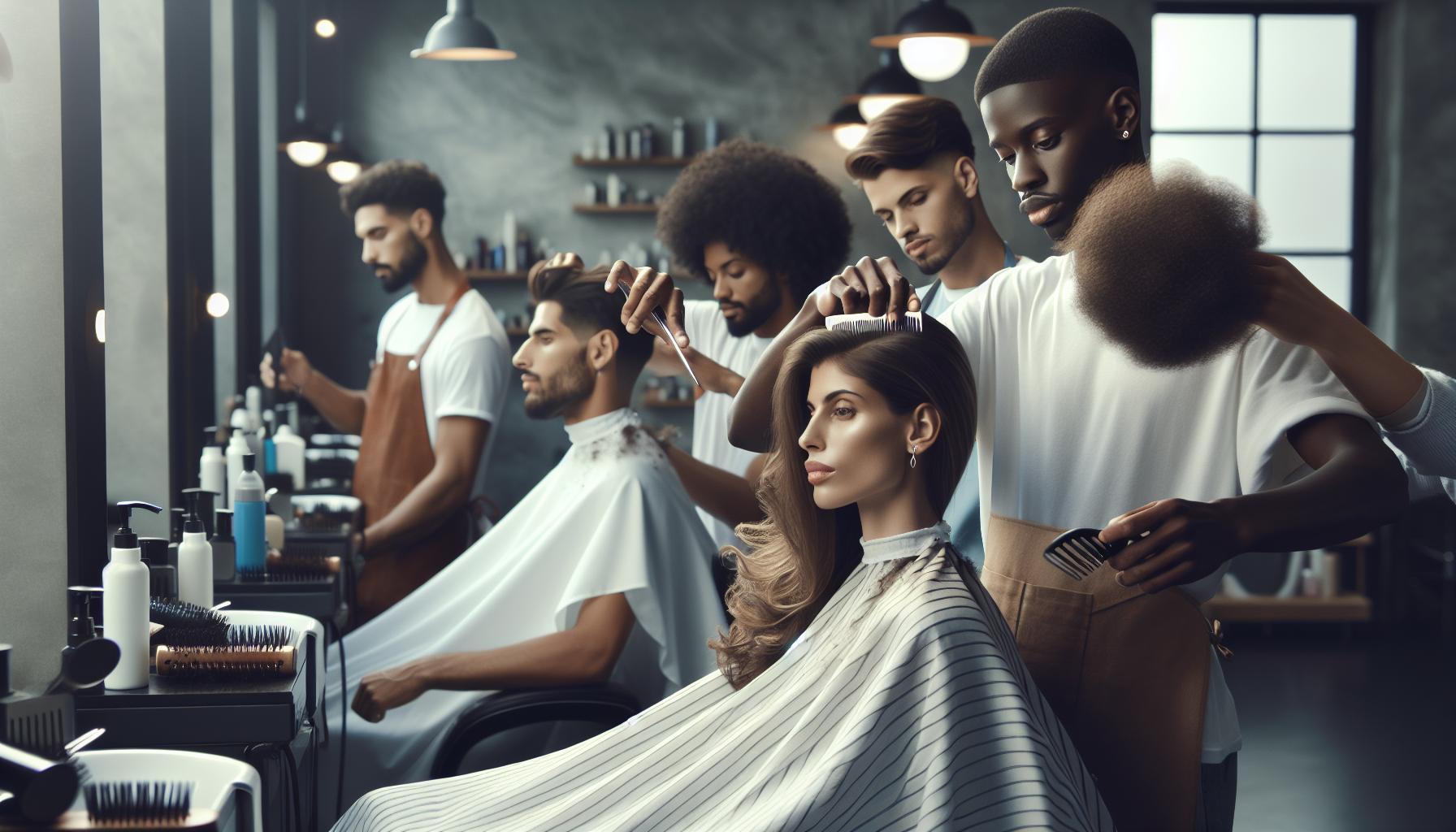Wondering how much your hair can grow in just one week? Understanding realistic hair growth rates is essential for anyone seeking to achieve longer locks or manage their hairstyles effectively. On average, hair grows about half an inch weekly, but various factors can influence this rate. Let’s explore what affects hair growth and how you can optimize it.
Contents
- Understanding Hair Growth: The Basics You Need to Know
- Average Hair Growth Rates: What to Expect in One Week
- Factors Influencing hair Growth: From Genetics to Lifestyle
- The Science Behind Hair Growth: How Hair Follicles Work
- Tips and Tricks to Support Healthy Hair Growth
- Common Myths About Hair Growth: separating Fact from Fiction
- The Emotional impact of Hair Growth: Connecting to Personal Identity
- When to Seek Professional Help: Hair Growth Concerns That Matter
- Frequently asked questions
- In Retrospect
Understanding Hair Growth: The Basics You Need to Know
Did you know that on average, human hair grows about half an inch (1.25 cm) per month? That translates to approximately 0.125 inches (0.3 cm) a week! While this rate can vary widely depending on various factors,understanding the basics of hair growth can empower you to make informed decisions about your mane.
Hair growth is a complex biological process influenced by genetics,age,health,and even diet. The hair growth cycle consists of three main phases: anagen, catagen, and telogen. During the anagen phase, hair is actively growing, which can last from two to seven years. Next, the catagen phase is a short transition period lasting a few weeks, where hair growth stops and the hair follicle shrinks. in the telogen phase, hair rests for about three months before being shed—making way for new growth.
To further understand the realistic hair growth rates, consider the following factors:
- Genetics: Your genetic makeup plays a significant role in determining hair growth rates. If your parents had thick, fast-growing hair, you might too.
- Age: Young individuals typically experience more vigorous hair growth compared to older adults, due to hormonal changes and overall health.
- Health and Nutrition: A well-balanced diet rich in vitamins and minerals can enhance hair growth. Nutrients such as biotin, zinc, and vitamins A and E are notably beneficial.
- Hormonal Changes: Fluctuations in hormones, especially during puberty, pregnancy, or menopause, can substantially impact hair growth rates.
For those curious about how thes factors can affect hair growth week by week, the table below outlines the expected hair growth based on average conditions:
| Time (Weeks) | Average Growth (inches) | Variability (inches) |
|---|---|---|
| 1 | 0.125 | 0.05 – 0.2 |
| 2 | 0.25 | 0.1 – 0.4 |
| 3 | 0.375 | 0.15 – 0.6 |
| 4 | 0.5 | 0.2 – 0.8 |
By being aware of these growth patterns and factors, you can tailor your hair care routine, ensuring you’re doing everything possible to boost your hair health. Whether you’re seeking to grow long locks or simply maintain your current length, knowing the insights behind hair growth can aid in setting realistic goals.
Average Hair Growth Rates: What to Expect in One Week
Did you know that the average human scalp produces approximately half an inch of hair growth each month? That translates to around 0.12 inches in just one week. While this may seem minimal, understanding the factors that contribute to hair growth can definitely help you set realistic expectations and develop effective hair care strategies to optimize your hair’s health and appearance.
Several elements influence the growth rate of your hair, including genetics, health, diet, and even seasonal changes. Here’s a quick look at some of these factors:
- Genetics: Your hereditary background plays a crucial role in determining how quickly your hair grows. If your parents had lush locks, you might be blessed to inherit a similar growth trait.
- Age: Hair tends to grow faster in young adults and slows down as you age due to changes in hormone levels.
- Diet: Nutrient-rich foods promote healthy hair growth. Vitamins such as Biotin, Vitamin D, and minerals like zinc are essential for maintaining strong follicles.
- Health Conditions: Certain medical conditions and hormonal imbalances can impede growth, so maintaining overall health is vital.
Its crucial to note that while everyone’s growth rate differs, observing changes over the short term can be enlightening. after one week, if you notice a slight increase in hair length or changes in texture, it can be encouraging.
| Week | Average Hair Growth (Inches) |
|---|---|
| 1 | 0.12 |
| 2 | 0.25 |
| 3 | 0.39 |
| 4 | 0.5 |
To optimize your hair growth, consider implementing a routine that focuses on nourishment and scalp care.Consuming a balanced diet and staying hydrated are essential. You might also benefit from regular trims to remove split ends, which can hinder healthy growth. By understanding how long hair grows in a week and utilizing actionable strategies, you can help ensure that your hair thrives and flourishes over time.
Factors Influencing hair Growth: From Genetics to Lifestyle
Every strand of hair on your head carries a story, influenced by an intricate blend of factors ranging from the blueprint of your DNA to the choices you make in your daily life. While the average hair grows about half an inch per month or roughly 0.125 inches per week, understanding the varied elements that contribute to this process can help you manage your expectations and perhaps even enhance your hair’s growth potential.
Genetic Factors
Genetics plays a pivotal role in determining not just the rate of hair growth, but also the thickness, texture, and overall health of your hair. If you’ve ever wondered why some people have luscious, voluminous locks while others seem to struggle with thinning hair, the answer frequently enough lies in inherited traits. Specific genes are responsible for hair follicle activity and the hair growth cycle, influencing how quickly and how much hair grows. If you’re keen on understanding your hair growth potential, consider talking to your family members about their hair history; this could provide valuable insights into your own hair attributes.
Hormonal Influence
Our hormones are powerful players in the hair growth game. Fluctuations in levels of hormones like estrogen and testosterone can significantly impact the hair growth cycle. As an example, women may notice changes in hair growth during pregnancy when estrogen levels surge, resulting in thicker, fuller hair. Conversely, hormonal imbalances during menopause can lead to increased hair loss. To support healthy hair growth, it’s essential to maintain hormonal balance through a well-rounded diet, regular exercise, and stress management techniques.
Lifestyle Factors
Lifestyle choices can either foster a conducive environment for hair growth or hinder it. Key factors include:
- nutrition: A diet rich in vitamins, minerals, and proteins is essential. Include foods high in biotin, zinc, and omega-3 fatty acids to promote healthy hair.
- Hydration: Adequate water intake maintains hydration not just for your body, but also for your hair follicles.
- Stress: Chronic stress can lead to hair loss, so incorporating relaxation techniques like meditation and yoga can help manage stress levels.
- Hair Care Routine: A gentle hair care regimen that avoids harsh chemicals and excessive heat can prevent breakage and support growth.
To see the impact of these lifestyle choices, you might consider tracking your hair growth over a few weeks while adjusting one factor at a time. Keeping a record can definitely help you identify the most effective strategies for your hair type.
Environmental Conditions
Lastly, don’t underestimate how outside factors can have a direct impact on hair growth. Seasonal changes, humidity levels, and even pollution can affect both the health of your hair and the rate at which it grows. For example, dry winter air can lead to a brittle texture, while summertime humidity may encourage oiliness.Protecting your hair by using appropriate hair products tailored to your environment can be crucial.
while understanding “how long does hair grow in a week?” is helpful, the growth rate itself is influenced by a mosaic of genetics, hormonal balance, lifestyle choices, and environmental conditions. By being mindful of these factors,you can take meaningful steps toward achieving your desired hair growth outcomes.
The Science Behind Hair Growth: How Hair Follicles Work
Hair growth is a engaging process influenced by various biological factors. Understanding how hair follicles work can demystify the often-asked question: “How long does hair grow in a week?” Typically, hair grows at an average rate of about half an inch per month, which translates to roughly 0.125 inches per week. Though, this rate can vary based on factors such as genetics, age, and overall health.
At the core of hair growth are the hair follicles, small, pouch-like structures in the skin that produce hair. Each follicle is connected to a sebaceous gland,which produces oil to keep the hair healthy. The hair growth cycle consists of three main phases:
- Anagen Phase: This is the growth phase, where the hair follicle is active and cells rapidly divide, producing new hair. This phase can last anywhere from 2 to 7 years and is vital for achieving longer hair.
- Catagen phase: A transitional phase lasting about 2 to 3 weeks, where the growth slows, and the hair follicle shrinks. This is when hair detaches from the blood supply.
- Telogen Phase: The resting phase, during which the hair falls out and the follicle becomes dormant for about 3 months, before re-entering the anagen phase to start the cycle anew.
The Role of Nutrition and Health
The health of hair follicles is significantly influenced by nutrition and overall health. Consuming a well-balanced diet rich in vitamins and minerals can promote optimal hair growth. Key nutrients include:
| Nutrient | Benefits for Hair Growth |
|---|---|
| Biotin | Supports the production of keratin and may improve hair growth. |
| Vitamin D | Stimulates new hair follicle growth and prevents hair thinning. |
| Iron | Helps red blood cells carry oxygen, which is crucial for healthy follicles. |
By ensuring an adequate intake of these nutrients, you can definitely help your hair follicles function at their best and perhaps influence the realistic growth rates of hair, answering the ever-popular question of how long hair grows in a week. This understanding emphasizes that while genetics dictate many aspects of hair growth,lifestyle choices play a critical role in shaping your overall hair health.
Tips and Tricks to Support Healthy Hair Growth
Did you know that hair typically grows about half an inch per month, which translates to approximately 1.5 inches in three months? While factors like genetics and health play significant roles in hair growth, there are several actionable tips and tricks that can definitely help you maximize your hair’s potential. By adopting healthy hair care habits and making mindful lifestyle adjustments, you can create an optimal environment for growth and thickness.
Adopt a Nutrient-Rich Diet
What you eat has a profound impact on your hair health. A balanced diet rich in vitamins and minerals can contribute significantly to hair growth. Focus on including:
- Protein: Hair is primarily made of keratin, a protein. Incorporate eggs, fish, beans, and nuts to ensure adequate protein intake.
- Vitamins: Vitamins A, C, D, and E are essential for hair health. Foods like spinach, avocados, and sweet potatoes are excellent sources.
- Minerals: Zinc and iron are crucial for maintaining healthy hair. Consider adding lean meats, oysters, and lentils to your meals.
Maintain Scalp Health
A healthy scalp is key to effective hair growth.regularly massaging your scalp can increase blood flow and stimulate follicles. Utilize oils like castor or coconut oil during your massage, as these oils have properties that can nourish and protect the scalp.Incorporating natural remedies can also boost scalp health; for instance, using aloe vera or tea tree oil can help manage conditions like dandruff, which might inhibit growth.
Practice Gentle Hair Care
How you handle your hair matters immensely. being gentle during washing and styling can prevent breakage and damage. here are some tips to consider:
- Use a mild, sulfate-free shampoo to cleanse your hair without stripping away natural oils.
- Limit the use of heat styling tools—opt for air drying and natural styles whenever possible.
- Use wide-toothed combs and detangle your hair carefully to prevent breakage.
Taking these steps will not only foster a healthier environment for hair growth but also optimize results in how long hair grows in a week. When you combine a nutrient-filled diet with proper scalp care and gentle handling techniques, you’ll likely see improvements in your hair’s growth rate and overall health.
Common Myths About Hair Growth: separating Fact from Fiction
Everyone desires luscious locks and wishes to unlock the secrets of hair growth. Though,many myths surrounding the subject can lead to confusion and unrealistic expectations. Understanding the truths about hair growth can empower individuals to adopt healthy habits that may enhance their hair’s potential. Let’s dive into some of the most common misconceptions about how hair grows and see what the facts really say.
Myth 1: Cutting Hair Makes It Grow Faster
One prevalent belief is that regular trims can accelerate hair growth. In reality,hair growth occurs at the follicle level beneath the scalp and is unaffected by cutting the strands. However, trimming hair can eliminate split ends and breakage, creating the appearance of healthier, thicker hair, and thus may make you feel as though your hair is growing faster.
Myth 2: Hair Growth is Affected by Diet Alone
While it’s true that nutrition plays a significant role in overall health, including hair health, the idea that eating certain foods will dramatically enhance growth rates beyond the natural cycle is misleading.For instance, a diet rich in vitamins and minerals can support optimal growth, but it won’t shift the inherent growth rate. The average hair grows about half an inch (1.25 cm) per month, or around 0.2 to 0.5 inches (0.5 to 1.25 cm) a week.
| Growth Rate | Approximate Growth in a Week |
|---|---|
| Average Hair Growth | 0.2 to 0.5 inches (0.5 to 1.25 cm) |
| Healthy Hair Growth | Up to 0.7 inches (1.8 cm) |
| postpartum Hair Growth | Varies widely, can exceed average rates |
myth 3: hair Growth is the same for Everyone
Another myth is that hair growth rates are uniform across all individuals. In truth,numerous factors influence how quickly hair grows,including genetics,age,hormonal changes,and overall health. As a notable example, younger individuals frequently enough experience faster hair growth due to higher levels of collagen and other growth-promoting factors.
Understanding that genetic predisposition and individual health can shape your hair’s growth can help to set realistic expectations for yourself. Rather than striving for an arbitrary growth standard, focus on nourishing your hair and scalp through proper care and a balanced diet tailored to your needs.
By demystifying these common misconceptions, you can better navigate the world of hair growth, making informed choices that suit your hair and lifestyle. Remember, while you cannot fundamentally change how long your hair grows in a week, you can certainly maximize your hair’s health and appearance with the right approach.
The Emotional impact of Hair Growth: Connecting to Personal Identity
The relationship between hair growth and personal identity is profound, frequently enough intertwined with our self-perception and cultural narratives. For many, the question of “how long does hair grow in a week?” transcends mere curiosity about biological growth rates; it touches on deeper feelings associated with personal transformation, self-expression, and societal expectations. Hair is frequently seen not just as a biological feature but as a canvas for identity. Changes in hair length or style can signal emotional states, life decisions, or transitions, further influencing how we see ourselves and how we are perceived by others.
One of the most striking elements of hair growth is its connection to a sense of control over one’s appearance. When individuals engage in practices to promote healthy hair growth or explore various styles, they frequently enough find a renewed sense of agency.The process of waiting for hair to grow out can be a journey of patience and self-acceptance.As hair inches forward—often an average of half an inch per month in realistic growth rates—so too can personal confidence and self-identity blossom. For someone recovering from a challenging time in their life, choosing to grow out their hair can be symbolic of healing and rebirth.
In various cultures, hair holds significant meaning, frequently enough representing traditions, beauty standards, and personal narratives. As an example, some may grow their hair long as a display of cultural pride or connection to ancestry, while others might opt for a radical change to signify a fresh start. Below are some cultural insights into the emotional significance of hair in different contexts:
- African cultures: In many African societies, hair is deeply tied to identity, history, and community. Hairstyles can indicate social status and personal milestones.
- Western societies: Here, hair length and style frequently change with trends, reflecting individualism and the spirit of the times.
- Asian cultures: In some Asian cultures, long, healthy hair is traditionally viewed as a sign of femininity and grace.
Understanding realistic hair growth rates not only quells the curiosity of how long it takes to achieve desired lengths but also contextualizes the emotional investment people place in their hair. When embarking on a hair growth journey, practical steps can enhance the experience:
Practical Tips for Nurturing Hair Growth
| Tip | Description |
|---|---|
| Healthy Diet | Incorporate vitamins and minerals such as biotin, vitamin E, and omega-3 fatty acids to promote hair health. |
| gentle Hair Care | Avoid harsh treatments and use sulfate-free shampoos to reduce damage and breakage. |
| Regular Trims | trimming split ends can help maintain overall hair health, encouraging healthier growth. |
embracing the emotional journey tied to hair growth enriches the experience and fosters a deeper understanding of self. Whether it’s a slow and steady change or a dramatic transformation, recognizing the underlying significance can empower individuals as they navigate their unique paths of identity and expression.
When to Seek Professional Help: Hair Growth Concerns That Matter
Experiencing changes in your hair growth can be both alarming and confusing. While it’s important to understand that hair typically grows about half an inch per month—approximately 0.17 inches per week—the reality is that various factors can significantly impact growth rates. If you find yourself wondering how long your hair should be growing in a week, and if it’s not meeting those expectations, it may be time to consider professional help. Here are some indicators that warrant a visit to a specialist.
Signs you Should Consult a Professional
Recognizing when it’s time to seek advice from a dermatologist or hair specialist can prevent long-term issues. Consider these scenarios:
- Sudden Hair Loss: If you notice an abrupt change in hair thickness or an increase in shedding,especially if clumps of hair are falling out,this is a significant red flag.
- Thinning Patches: The appearance of bald spots or thinning areas on the scalp may indicate underlying conditions that require professional assessment.
- Excessive Breakage: When hair strands routinely break or become brittle, it can be indicative of health concerns or environmental damage.
- Changes in Hair Texture: If you notice a drastic alteration in how your hair feels—becoming coarse, frizzy, or greasy—this could signal issues worth investigating.
- Itchy or Flaky Scalp: Persistent irritation, scaling, or flakiness can suggest scalp disorders that may hinder healthy hair growth.
Common Conditions Affecting Hair Growth
Understanding potential medical conditions is essential for addressing hair growth concerns. Some common conditions include:
| Condition | Description |
|---|---|
| Alopecia Areata | An immune system attack on hair follicles leading to patchy hair loss. |
| Androgenetic Alopecia | A hereditary condition causing gradual thinning, often referred to as male or female pattern baldness. |
| Telogen Effluvium | A temporary condition triggered by stress, hormonal changes, or traumatic events, resulting in significant shedding. |
| Scalp Psoriasis | An autoimmune condition causing red patches of skin and flaking that can disrupt hair growth. |
When to Book an Appointment
if you’re experiencing troubling symptoms, prompt action could make a considerable difference. Here are practical steps to take:
- Document Changes: Keep a diary of when you notice changes, including any relevant lifestyle factors such as diet or stress levels.
- Consult Your Primary Care Provider: Begin by discussing your concerns with your general practitioner, who can provide referrals to specialists if necessary.
- be Prepared for Questions: Professionals may ask about family history, recent stressors, or changes in your diet and health, so be ready with that information.
Understanding how long hair grows in a week, along with realistic growth rates, can serve as a helpful benchmark. If your progress doesn’t align with what’s typical or if you experience adverse symptoms, don’t hesitate to seek professional guidance. The sooner you take action, the better your chances of addressing any underlying issues successfully.
Frequently asked questions
How long does hair grow in a week? Realistic Growth Rates?
On average, hair grows about 0.5 inches (1.25 cm) per month, translating to roughly 0.125 inches per week. Individual growth rates can vary due to factors like genetics, health, and age.
While some people may experience slightly faster or slower growth, the general consensus is that hair grows at a relatively consistent rate. Moreover,factors like diet or hair care routines can influence these rates. For more information on supporting optimal hair health, check out our guide on healthy hair practices.
What affects the rate of hair growth?
The rate of hair growth can be influenced by several factors including genetics, hormonal changes, diet, and overall health. Conditions like stress or illness can also impact hair growth.
for instance, a diet rich in vitamins and proteins can stimulate hair growth, while deficiencies might slow it down.Furthermore, hormonal changes, such as those experienced during pregnancy or menopause, can affect hair growth rates significantly.
Can I increase my hair growth in a week?
While you can’t drastically increase your hair growth in just a week, certain practices can definitely help maintain healthy hair and possibly enhance growth over time. Key strategies include a balanced diet and proper hair care.
Incorporating foods rich in vitamins like B and E,along with regular scalp massages,can promote better blood circulation and optimize hair growth conditions. While results won’t be immediate, these practices contribute to long-term health and growth.
Why does hair growth differ from person to person?
Hair growth rates differ between individuals due to a mix of genetic, hormonal, and lifestyle factors. Such as, some people may have fast-growing hair due to their genetic predisposition.
Additionally, environmental factors like climate and hair care habits can also play significant roles. keeping your hair clean and well-nourished can help maximize its growth potential nonetheless of your base rate.
What is the normal hair growth cycle?
Hair grows in cycles consisting of three main phases: anagen (growth), catagen (transition), and telogen (resting). The anagen phase can last from 2 to 7 years,greatly affecting the length of your hair.
Understanding these phases can clarify why some people experience rapid growth, while others may notice hair thinning or loss. Good hair care can help ensure more hair remains in the anagen phase longer.
Can hair products affect growth?
Hair products can indeed influence growth rates by either promoting health or causing damage. Using products containing harsh chemicals can lead to breakage and hair loss.
Conversely, high-quality products with nourishing ingredients can help maintain your hair’s health. Ultimately, choosing the right hair care products can contribute positively to your hair growth journey.
How does hair care impact hair growth?
Proper hair care is crucial for maximizing growth potential. Gentle washing, conditioning, and minimizing heat damage play significant roles in maintaining hair health.
Investing time in a regular hair care routine can boost your hair’s natural growth rate. For best results, consider using natural oils and treatments that nourish and protect hair from damage.
In Retrospect
understanding how long hair grows in a week—typically around 0.5 to 1.5 centimeters, depending on various factors like genetics and overall health—empowers you to better manage your hair care journey. We’ve explored the intricate biology of hair growth, highlighting the role of factors such as diet, hair care practices, and lifestyle choices. Remember, it’s not just about the numbers; it’s about nurturing your hair through informed decisions.
If you find yourself grappling with concerns such as hair loss or damage, know that you’re not alone, and there are effective strategies available. From optimizing your nutrition to choosing the right products for your hair type, practical steps can lead to noticeable improvements over time.
We encourage you to delve deeper into your hair care routine and explore additional resources.Whether you’re considering changes or seeking support,embrace the journey toward healthier hair—after all,your hair reflects your unique story. Don’t hesitate to reach out with questions or share your experiences as we navigate this together!

